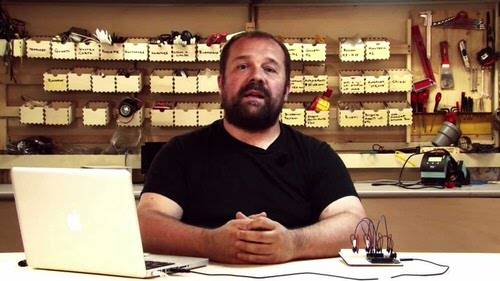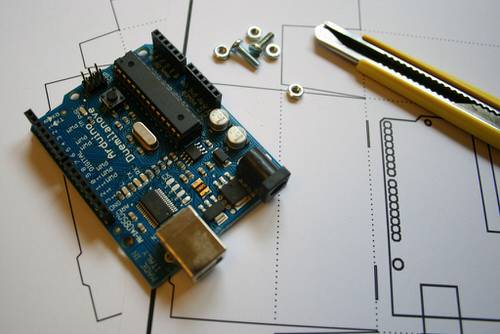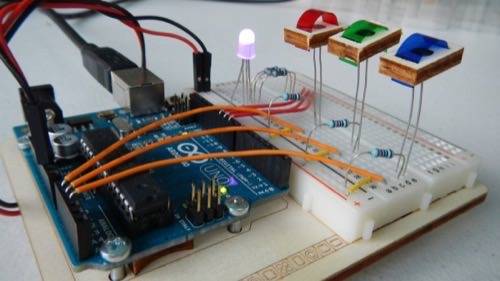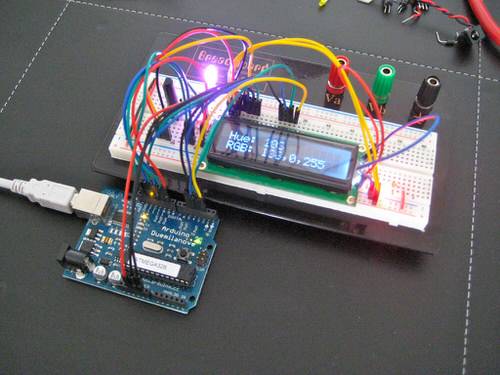
ReadWriteBuilders is a series of interviews with developers, designers and other architects of the programmable future.
In 2005, Massimo Banzi was a teacher at the Interaction Design Institute Ivrea in Ivrea, Italy. He wanted his students to prototype the projects they designed, and that meant an introduction to electrical engineering.
At the time, commercial hardware hacking tools available to students were expensive and difficult to use. Banzi’s students came from different backgrounds and skill levels, and traditional computer science wasn’t going to cut it.
Banzi had a problem. And as he’d done so many times before in his life, he turned to tinkering to solve it.
His solution: Arduino, a high-tech, DIY electronics kit with a cheap programmable computer—a so-called microcontroller—at its core.
Intended as a teaching tool to introduce students to electronics, the cheap and easy device has been adopted by the maker movement. Today you can find hundreds of inventive, replicable DIY Arduino projects on the Internet. Thanks to its accessible design, it’s arguably the most influential open-source hardware movement of its time.
Just because Arduino is easy to use and affordable doesn’t mean it’s limited. Since it can attach to a multitude of sensors, even beginners can make some pretty incredible projects based on the Arduino platform, from a thermostat to an ambulatory robot.
Nine years later, Banzi is the CEO of Arduino—now a company as well as a device and a movement. I talked to him about the making of Arduino and what’s in store for its future.
The Making Of A Maker

RW: How did you get started in technology?
Massimo Banzi: I guess I was very curious to understand how things work, so that was what I started with. Some of my relatives would bring things to my home so I could take them apart.
See also: Arduino Rising: 10 Amazing Projects For The Tiny Microcontroller
Once I learned how things worked, I wanted to learn how to do things so I would get these Lectron modules from Germany that came with a book. It would explain how you to build a circuit to make a radio, to make an amplifier, all sorts of devices. That was the way I started with technology and I started with electronics. It was fun to build things. I was eight, I think.
RW: How did that lead eventually to Arduino?
MB: I did study electrical engineering. But then I dropped out of college because it was (laughs) boring, and I was doing much more exciting stuff outside. And so I spent a long time just working with software.
Later I started teaching at a design school [Interaction Design Institute Ivrea]. Students would design interactive products. They would have about 30 days to learn enough electronics to build their prototypes, and so we had to come up with a way to teach them technology quickly.
It was a little bit mixed. Some had backgrounds in computer science, others in art, design, psychology. It was really diverse. Even the people who did know software, they had to learn the whole process of building the device that fit the design.
Start In A Bar
RW: What were some of the biggest hurdles you had to overcome during the Arduino project?
MB: Well, at the end of the day, a lot of the technologies we needed had been made by other open source projects. So in a way we were lucky that we had the tools needed for building a very functional and high quality compiler that we could turn into the base of Arduino. The biggest challenge was to put the Arduino into a package so [that] you plug it in and it just works.

This kind of “plug and play” nature requires quite a lot of work. About 20 percent of the project has been setting that up. Also at the beginning, I have to say that very few people cared about this. So obviously there wasn’t a lot of market. We had to put forth some of our own money, we didn’t make any money for a long time. So we had to build Arduino as a side project, as something that we’d do while we were doing other things.
RW: Is that why Arduino came to be named after—and invented in—a bar?
MB: (Laughs) When we had to come up with a name, the first name that kind of came to mind was this bar, Arduino, so we used the name of the bar. Also, it’s a good name because there are a lot of things called Arduino in the town of Ivrea. I picked a name that I saw a lot while I was going around Ivrea.
Yeah, we worked on it, but it wasn’t something the school expected me to invent. We created it because I wanted to give my students better tools, and the tools on the market were very expensive, and they were for people who already knew about technology. I wanted to make something simpler, and it worked.
RW: Arduino was a group effort. But you made the first prototype?
MB: Yeah, I made the first prototype, then I got organized. I had made something like Arduino before, a few years previously, like two years before Arduino, and I realized that working by myself like that is very, very complicated. I wanted to have a team and a community.
So I started to ask some people that I knew to join the project. I asked a visiting [teacher] from Sweden, some of my students, and [a teacher] from New York who was teaching the same kind of students as I was, to provide their ideas and help. One of my students did the software part because he is a quite talented software developer. And so before I knew it I’d assembled a team.
RW:What is your involvement with the Arduino project today?
MB: At the moment, my role is to be the CEO of Arduino, although I’m not exactly the kind of CEO you see normally on TechCrunch. We’re still a very small company and each one of us has about 20 different roles. I guess me, Gianluca, and David are the only ones who work at Arduino full time. The other people work mostly on the side as they teach a lot. We have a number of people who work with Arduino in Italy and Sweden and the U.S. on teams spread around two coasts.
RW: Do you travel between Italy and America often to work on Arduino?
MB: At the moment I’m spending a lot of time in the US because we don’t really have a real office in the US but a lot of the things that happen in our market are driven a lot by what happens here in the US. So at the moment I’m spending a lot of time in New York, and I’m trying to figure out if we can open our own office here where there are a lot of makers, and it’s a very central place for the maker community.
Viva La (Maker) Revolución!

RW: What do you think about the popularity of the maker movement? That started getting big after Arduino was already a thing, right?
MB: Yes. We sort of happened in the right moment because the moment people started getting into hardware again, they found Arduino was a tool they could use. So people realized they could use Arduino to build circuits and make prototypes. The kind of people who are amateurs or doing it for fun or trying to solve a specific problem. It became a world of possibilities where people were even starting to make companies out of their Arduino prototypes.
It’s quite interesting. We were adopted by the maker movement as their electronics platform, and the great thing about that is there are a lot of people that never thought they could program microcontrollers, never thought they would make circuits. And they end up making startup companies making electronic products, something which, 15 years ago, was very, very difficult and was available only to people who had experience in electronics.
I’m really pleasantly surprised at this fast change in the way people can use Arduino to create products even if they don’t have a lot of experience in electronics.
RW: How popular is Arduino right now, numerically speaking?
MB: At the moment there are 1.2 million official Arduinos out there in the wild, but I’m sure there are just as many Chinese counterfeit copies.
Over a three-month period, the website normally sees about 4 to 5 million users, of which 3 to 4 million are regular visitors. The size of the community is much larger than the number of official Arduinos that we’ve made, so the community is now embracing Arduino-compatible devices.
And the forum has about 200,000 active users, which is a good number of people who are asking questions and helping each other, which is really pretty cool. But I guess the fact that 4 to 5 million visit our website is the most interesting part. I never imagined this many people would be interested in Arduino.
RW: I realize you don’t teach as often now that you’re CEO, but how does Arduino figure into classes for product design students?
MB: I still teach at a couple of universities because teaching is a good R&D [research and development] exercise. Normally when I teach, I present a problem or issue to my students, and ask them to come up with a way to solve it.
For example, I just taught a class last year where we tried to figure out what happens when people try to use connected devices when they first bring them into their homes. I wanted them to see what technology can solve for them so we explore a number of concepts using these devices so they can actually see if their ideas make sense.
I’ve also told students to take products out of the garbage and try to give them a new life. For example they’ve redesigned a record player to become a special type of lamp. It’s a way to push them to think about technology in a different way so they can make different things using technology.
RW: What do you think about Arduino’s adoption beyond students and what that says about the world? Are we turning into a world of DIY hackers?
MB: I guess the question is—it always is—whenever you design a tool that allows people to be creative, there are people who will start to be creative with the tool. Once we made that available, people are now responding and creating. So it’s not so much that we’ve become a world of people who do hardware hacking, but, I guess, a world where people are becoming more involved in the creation of products.
You can already see this. There are a lot of small companies that are starting up on Indiegogo with an idea, and they find a few thousand people who like their idea, so I think it’s changing the way we design products.
In the 21st century, a large number of the products we use now have technology inside. So what if we all approach technology in order to change the products that people use? We can provide different products, or additional products that work with existing ones.
I guess the fact that we’re more and more aware of the technologies in our products, helps us to consider products and services of different kinds, to design devices that will be useful to people. It opens up a door to people who have different points of view on technology.
At the moment, most of the people making technology have one perspective, and traditional business models. But hardware hacking opens up technology to different parts of the world and different ideas, so I can tell we’ll soon have a much larger multitude of ideas.
The Future of Arduino

RW: You’ve certainly designed a lot of Arduino models—the Uno, the Due, the Mega, the Nano, the Shield. Why are there so many versions?
MB: When people find they don’t have enough memory with the Uno, they move onto the Mega. Or they find they run out of computing power, and move onto the Due.
We wanted to provide different versions that would work for different types of projects. The more we work with the platform, the more people demand an Arduino that does a certain thing. So we design new products to meet their demands. The more the community responds and requests more products, the more we provide.
I usually come up with a high level design that reflects the features that the model requires, we discuss it with the team and then we pass it on to our engineers.
RW: What’s next for the Arduino project?
MB: We’re working on the Arduino Tre, which will be a super small Linux machine, kind of like the Raspberry Pi, that can work with a screen and a keyboard. But even simpler than that, because we want people without a lot of experience in technology to be able to just plug it in and use it. Even if they don’t understand Linux yet.
The Arduino Tre comes out in a few weeks. There is going to be a beta program so people can get a preview of the hardware and start working on it, hopefully on the fifth of May, I’m still waiting for confirmation on that. People will be able to pay a little bit more to join the beta program and get an Arduino Tre a little earlier than everyone else.
We’re also working on ultimately providing more tools for people online, and not just producing more hardware.
Lead photo courtesy of Arduino; other Arduino images by Flickr users oomlout, hdaniel and Manoel Lemos










